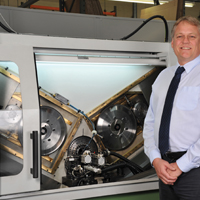 Working Without Waste
Working Without WasteIn the quest for ever greater sustainability, manufacturing companies are looking to make savings every which way without compromising quality.
Cold forming is a metal manufacturing process that not only cuts waste but improves the integrity of component parts, says Mark Jennings, Engineering Director at Dawson Shanahan. (Read More)
Material costs for manufacturers of metal components remain a major concern, but there are now an increasing number of options available with which to cut costs and achieve a more efficient and sustainable manufacturing programme. With environmental legislation rising high on the agenda and an increasingly discerning customer base when it comes to sustainability, manufacturing companies should consider the significant cost reductions that can be brought by cold forming, especially since they bring benefits that are not only ecological but financial. The best way to start when cutting back on waste and inefficiency is to go for the largest targets and reducing waste metal is a good place to start.
Cold forming
Cold forming is a manufacturing process by which metal is shaped without removing material. A simple blank (either sawn or cropped from a round bar or wire or as a cold headed pre-form) is placed within a die and a punch is pressed into the blank at ambient temperature. The blank then takes on the form of the punch and the die. Put more simply, cold-forming is making a shape from material at room temperature, just like Plasticine when it is pushed into a mould. With appropriate force and cold forming technique, materials such as copper, aluminium, brass and even stainless steel can be formed to the required shape.
In cold forming, the metal is stretched beyond its yield strength, so that it takes on and retains the exact shape of the mould, but without adversely affecting the grain structure. Unlike conventional machining, where the material removal processes cut across the grain structure of each part, cold forming allows the grain structure of the material to follow the contours of the die or mould. As a result, the strength of the part is maximised along its length, while internal surfaces take on a highly polished finish.
This process can cut production costs without sacrificing the quality of components. Indeed, cold forming offers not only big material savings but also an enhanced surface finish and improved mechanical characteristics. And because it retains the integrity of the metal, while also producing parts with highly polished surfaces, the performance of a component can be improved dramatically. Along with producing simple, high volume components like fasteners, cold forming is now increasingly used to produce precision components in, for example, laser and Plasma applications where cold-formed consumables can improve performance and significantly reduce costs compared to conventionally machined CuTe consumables. Thanks to cold forming, up to 80% material savings can be achieved, as well as time and costs saved that would otherwise have been incurred by machining. It can also aid product designers to produce complex geometric forms very quickly without the need for long machining cycles.
With growing demands from industry, combined with the need to reduce wastage rates and energy consumption for both economic and environmental reasons, an increasing number of manufacturers are adopting the method of producing components via cold forming. For those who are striving to maintain a profit margin in the face of high material costs, cold forming offers the opportunity to achieve a major reduction in costs simply by avoiding the waste of the precious metal they buy.
Dawson Shanahan Limited
Cranborne Industrial Estate, Potters Bar, Herts EN6 3JN
Tel: +44 (0) 1707 602 000
Email: This email address is being protected from spambots. You need JavaScript enabled to view it.
Web: www.dawson-shanahan.co.uk



